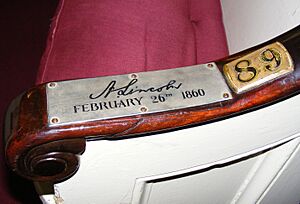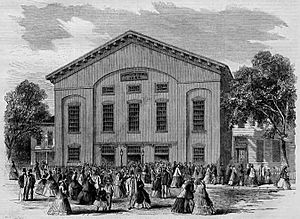Plymouth Church (Brooklyn) facts for kids
|
Plymouth Church
|
|
|
U.S. National Historic Landmark District
Contributing Property |
|
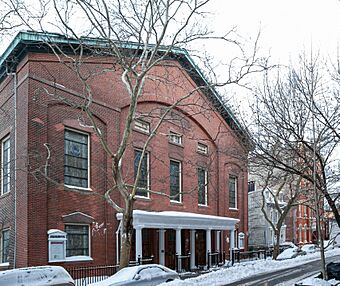 |
|
| Location | 57 Orange Street Brooklyn, New York |
|---|---|
| Built | 1849-50 |
| Architect | Joseph C. Wells Woodruff Leeming |
| Part of | Brooklyn Heights Historic District (ID66000524) |
| NRHP reference No. | 66000525 |
Quick facts for kids Significant dates |
|
| Added to NRHP | July 4, 1961 |
| Designated NHL | October 15, 1966 |
| Designated NHLDCP | January 12, 1965 |
Plymouth Church is a very old and important church in Brooklyn, New York City. It is located at 57 Orange Street in the Brooklyn Heights neighborhood. The church was built in 1849–50. It was designed by Joseph C. Wells.
Under its first leader, Henry Ward Beecher, Plymouth Church became a major center for the movement to end slavery in the mid-1800s. It has been recognized as a special historical place. It was added to the National Register of Historic Places in 1961. It became a National Historic Landmark in 1966. The church is also part of the Brooklyn Heights Historic District.
Plymouth Church is a member of the National Association of Congregational Christian Churches.
Contents
History of Plymouth Church
Plymouth Church was started in 1847 by 21 people from New England. They were part of a group led by rich business owners like Arthur and Lewis Tappan. Other important people involved included Henry C. Bowen. This was the third Congregationalist church in Brooklyn. Back then, Brooklyn was a separate city from New York. The land for the church was bought from the First Presbyterian Church. They needed a bigger space and moved to a new spot.
Fighting Against Slavery
Plymouth Church's first pastor was Henry Ward Beecher. He became a very important leader in the movement to end slavery. His sister was Harriet Beecher Stowe. She wrote the famous anti-slavery book Uncle Tom's Cabin. This book helped lead to the American Civil War.
The church itself became a secret stop on the Underground Railroad. This was a network that helped enslaved people escape from the South to Canada. People called the church "the Grand Central Depot." Enslaved people would hide in the secret basement tunnels. The Rev. Charles B. Ray, an African-American leader, said he often dropped off people seeking freedom at Plymouth Church. Plymouth Church is one of the few Underground Railroad churches still in its original building.
Mock Slave Auctions
One famous event at the church was Beecher's mock slave auctions. He would bring enslaved people into the church. Then, he would pretend to auction them off. But instead of selling them, he would set them free.
The most famous case was "Pinky." She was a 9-year-old girl who had escaped from Alabama. On February 5, 1860, Beecher started an auction for her. A collection plate was passed around. People gave $900 and a golden ring. Beecher put the ring on Pinky's finger. He said, "Remember, with this ring I do wed thee to freedom." Sixty-seven years later, Pinky, now a well-educated woman, returned the ring to the church.
Abraham Lincoln's Visit
In October 1859, the church invited Abraham Lincoln to speak. They offered him $200. Lincoln accepted and visited Brooklyn on February 26, 1860. He attended church services. Today, a plaque shows the pew where Lincoln sat.
Because so many people wanted to hear him, Lincoln's speech was moved to Cooper Union. People paid 25 cents to get in. Lincoln gave his famous anti-slavery speech there on February 27, 1860. This was more than eight months before he became President.
Other Famous Visitors
Many other famous people spoke at Plymouth Church. These included writers like Mark Twain and Charles Dickens. Activists like William Lloyd Garrison and Clara Barton also visited. In 1963, Martin Luther King Jr. preached a sermon there. It was similar to his famous "I Have a Dream" speech. More recently, Senator Hillary Clinton spoke at the church in 2001.
Church Mergers and Changes
In 1934, Plymouth Church joined with the Congregational Church of the Pilgrims. The new church was called Plymouth Church of the Pilgrims. The Congregational Church of the Pilgrims moved its beautiful stained-glass windows to Plymouth Church. These windows included some by Louis Comfort Tiffany. The church also has a 40-pound (18 kg) piece of Plymouth Rock. This rock is from where the Mayflower Pilgrims landed.
In 1958, the church decided not to join the new United Church of Christ. It stayed a member of the National Association of Congregational Christian Churches. In 2011, the church went back to its original name, "Plymouth Church."
Today, the church has about 425 members. They form a covenant community. This means each member makes a promise to God and to other members. The church helps many groups. These include anti-human-trafficking groups, a school in Cameroon, Habitat for Humanity, and Brooklyn anti-hunger programs.
In 2016, the Rev. Brett Younger became the 11th senior minister of Plymouth Church.
Architecture and Design
Plymouth Church was built in 1849–50. It is a good example of 19th-century urban tabernacle architecture. It has italianate and colonial styles. The church was designed by Joseph C. Wells. He helped start the American Institute of Architects.
The church building looks a bit like a barn or an auditorium. The seats are arranged in a curve around the pulpit. This open design was used by many evangelical Protestant churches in the United States.
In 1866, the church got a new pipe organ. It was the largest organ in the United States at the time. It was made even bigger in 1937.
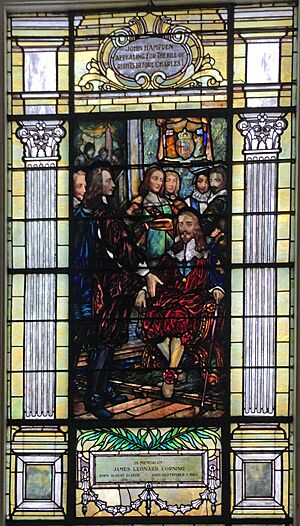
Stained-Glass Windows and Garden
From 1907 to 1909, the church added beautiful stained-glass windows. They were made by J&R Lamb Studios, one of the oldest studios of its kind in the US. These windows are special because they do not show Bible scenes. Instead, they show the history of democracy in England and the US. They focus on the influence of the Puritans, Pilgrims, and Congregational Churches.
In 1913, the family of John Arbuckle, a coffee merchant, gave money to create a large garden and a new parish house. The house and arcade were designed by Woodruff Leeming.
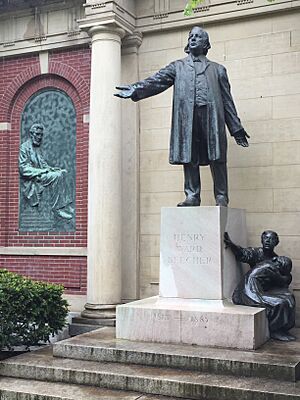
The church garden is on Orange Street. It has a statue of Henry Ward Beecher and a relief of Abraham Lincoln. Both were made by the famous sculptor Gutzon Borglum. He also created the Mount Rushmore National Memorial.
The church was added to the National Register of Historic Places on July 4, 1961. It was named a National Historic Landmark on October 15, 1966. It is part of the Brooklyn Heights Historic District.
You can take tours of the church. These tours include the garden, the main church area, Hillis Hall, and the original Underground Railroad facilities.
See also






